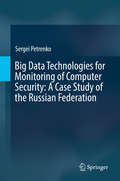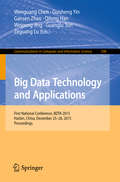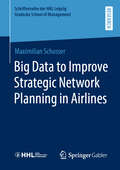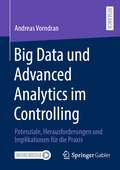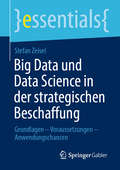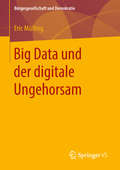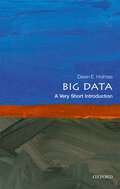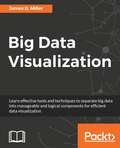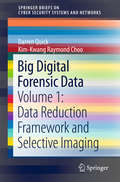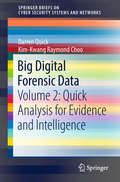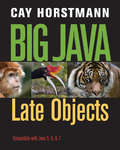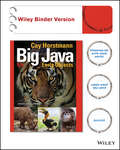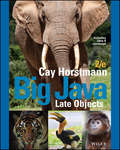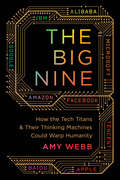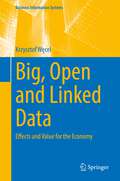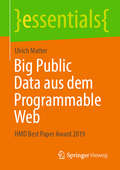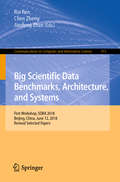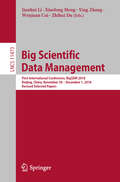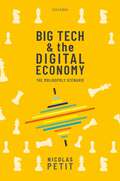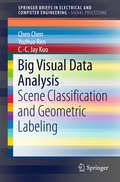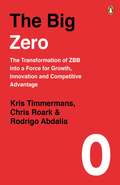- Table View
- List View
Big Data Technologies for Monitoring of Computer Security: A Case Study of the Russian Federation
by Sergei PetrenkoThis timely book offers rare insight into the field of cybersecurity in Russia -- a significant player with regard to cyber-attacks and cyber war. Big Data Technologies for Monitoring of Computer Security presents possible solutions to the relatively new scientific/technical problem of developing an early-warning cybersecurity system for critically important governmental information assets. Using the work being done in Russia on new information security systems as a case study, the book shares valuable insights gained during the process of designing and constructing open segment prototypes of this system. Most books on cybersecurity focus solely on the technical aspects. But Big Data Technologies for Monitoring of Computer Security demonstrates that military and political considerations should be included as well. With a broad market including architects and research engineers in the field of information security, as well as managers of corporate and state structures, including Chief Information Officers of domestic automation services (CIO) and chief information security officers (CISO), this book can also be used as a case study in university courses.
Big Data Technology and Applications: First National Conference, BDTA 2015, Harbin, China, December 25-26, 2015. Proceedings (Communications in Computer and Information Science #590)
by Wenguang Chen Guisheng Yin Gansen Zhao Qilong Han Weipeng Jing Guanglu Sun Zeguang LuThis book constitutes the refereed proceedings of the First National Conference on Big Data Technology and Applications, BDTA 2015, held in Harbin, China, in December 2015. The 26 revised papers presented were carefully reviewed and selected from numerous submissions. The papers address issues such as the storage technology of Big Data; analysis of Big Data and data mining; visualization of Big Data; the parallel computing framework under Big Data; the architecture and basic theory of Big Data; collection and preprocessing of Big Data; innovative applications in some areas, such as internet of things and cloud computing.
Big Data to Improve Strategic Network Planning in Airlines (Schriftenreihe der HHL Leipzig Graduate School of Management)
by Maximilian SchosserBig data has become an important success driver in airline network planning. Maximilian Schosser explores the status quo of network planning across a case study group consisting of nine airlines representing different business models. The author describes 23 big data opportunities for airline network planning and evaluates them based on their specific value contribution for airline network planning. Subsequently, he develops a financial evaluation methodology for big data opportunities based on key performance indicators for airline network planning departments.
Big Data und Advanced Analytics im Controlling: Potenziale, Herausforderungen und Implikationen für die Praxis
by Andreas VorndranDie Digitalisierung und Entwicklungen im Gebiet der künstlichen Intelligenz haben in den letzten Jahren erhebliche Veränderungen in der Gesellschaft und der Unternehmenspraxis hervorgerufen. Aufkommende Technologien in den Feldern Big Data und Advanced Analytics werden auch im Controlling zunehmend diskutiert oder bereits eingesetzt. Dabei befinden sich der Wissensstand, inwieweit Big Data und Advanced Analytics das Controlling beeinflussen und verändern können, und die praktische Anwendung noch in einem frühen Stadium. Diese Arbeit befasst sich deshalb mit der Untersuchung der möglichen Auswirkungen von Big Data und Advanced Analytics im Controlling. Vor diesem Hintergrund werden die Einflüsse dieser digitalen Trends auf den Informationsversorgungsprozess des Controllings, auf die Erfüllung Controlling-spezifischer Anforderungen an Informationen und auf das Forecasting, die Budgetierung und die strategische Planung analysiert. Ferner werden praxisrelevante Herausforderungen, Grenzen und Risiken bei der Implementierung und Nutzung identifiziert sowie Implikationen zu deren Umgang zur Ausschöpfung der Potenziale abgeleitet.
Big Data und Data Science in der strategischen Beschaffung: Grundlagen – Voraussetzungen – Anwendungschancen (essentials)
by Stefan ZeiselBig Data und Data Science sind Trends, die sowohl in der Wissenschaft als auch in Unternehmen auf großes Interesse stoßen. Dieses essential zeigt einen konzeptionellen Rahmen auf, um die Grundlagen von Big Data und Data Science besser zu verstehen. Einkaufsentscheider und Einkaufsorganisationen können dann aufbauend auf der Beschaffungsdigitalisierung sowie weiteren Datenquellen ein Big Data Warehouse konzipieren, welches die Voraussetzung schafft, um wichtige Beschaffungsprobleme zu lösen. Analytische Methoden werden genauso beleuchtet, wie neue Fähigkeiten in bereichsübergreifenden Teams. Abschließend werden 30 konkrete Anwendungsfälle von Big Data für die strategische Beschaffung vorgestellt.
Big Data und der digitale Ungehorsam
by Eric MüllingEric Mülling untersucht den Einfluss von Massendatenauswertung auf Netzaktivisten. Dazu interviewt der Autor u.a. den ehemaligen WikiLeaks-Aktivisten Daniel Domscheit-Berg, netzpolitik.org-Redakteur Andre Meister sowie die Netzkünstler Carmen Weisskopf und Domagoj Smoljo der !Mediengruppe Bitnik. Grundlage des Buches ist die politische Theorie des zivilen Ungehorsams. Durch die Analyse der Experteninterviews nach Identität, Subkultur, Gewissensentscheidung und Strategie entsteht die Idee zu einer eigenen Konzeption digitalen Ungehorsams. Die anschließende Darstellung der Effekte von Big Data auf die digitalen Protestakteure zeigt, wie die neue Technologie die Aktivisten gleichermaßen bedroht wie motiviert.
Big Data: A Very Short Introduction (Very Short Introductions)
by Dawn E. HolmesSince long before computers were even thought of, data has been collected and organized by diverse cultures across the world. Once access to the Internet became a reality for large swathes of the world's population, the amount of data generated each day became huge, and continues to grow exponentially. It includes all our uploaded documents, video, and photos, all our social media traffic, our online shopping, even the GPS data from our cars. 'Big Data' represents a qualitative change, not simply a quantitative one. The term refers both to the new technologies involved, and to the way it can be used by business and government. Dawn E. Holmes uses a variety of case studies to explain how data is stored, analysed, and exploited by a variety of bodies from big companies to organizations concerned with disease control. Big data is transforming the way businesses operate, and the way medical research can be carried out. At the same time, it raises important ethical issues; Holmes discusses cases such as the Snowden affair, data security, and domestic smart devices which can be hijacked by hackers. ABOUT THE SERIES: The Very Short Introductions series from Oxford University Press contains hundreds of titles in almost every subject area. These pocket-sized books are the perfect way to get ahead in a new subject quickly. Our expert authors combine facts, analysis, perspective, new ideas, and enthusiasm to make interesting and challenging topics highly readable.
Big Data: A Very Short Introduction (Very Short Introductions)
by Dawn E. HolmesSince long before computers were even thought of, data has been collected and organized by diverse cultures across the world. Once access to the Internet became a reality for large swathes of the world's population, the amount of data generated each day became huge, and continues to grow exponentially. It includes all our uploaded documents, video, and photos, all our social media traffic, our online shopping, even the GPS data from our cars. 'Big Data' represents a qualitative change, not simply a quantitative one. The term refers both to the new technologies involved, and to the way it can be used by business and government. Dawn E. Holmes uses a variety of case studies to explain how data is stored, analysed, and exploited by a variety of bodies from big companies to organizations concerned with disease control. Big data is transforming the way businesses operate, and the way medical research can be carried out. At the same time, it raises important ethical issues; Holmes discusses cases such as the Snowden affair, data security, and domestic smart devices which can be hijacked by hackers. ABOUT THE SERIES: The Very Short Introductions series from Oxford University Press contains hundreds of titles in almost every subject area. These pocket-sized books are the perfect way to get ahead in a new subject quickly. Our expert authors combine facts, analysis, perspective, new ideas, and enthusiasm to make interesting and challenging topics highly readable.
Big Data Visualization
by James D. Miller 2 28 2017Learn effective tools and techniques to separate big data into manageable and logical components for efficient data visualizationAbout This BookThis unique guide teaches you how to visualize your cluttered, huge amounts of big data with easeIt is rich with ample options and solid use cases for big data visualization, and is a must-have book for your shelfImprove your decision-making by visualizing your big data the right wayWho This Book Is ForThis book is for data analysts or those with a basic knowledge of big data analysis who want to learn big data visualization in order to make their analysis more useful. You need sufficient knowledge of big data platform tools such as Hadoop and also some experience with programming languages such as R. This book will be great for those who are familiar with conventional data visualizations and now want to widen their horizon by exploring big data visualizations.What You Will LearnUnderstand how basic analytics is affected by big dataDeep dive into effective and efficient ways of visualizing big dataGet to know various approaches (using various technologies) to address the challenges of visualizing big dataComprehend the concepts and models used to visualize big dataKnow how to visualize big data in real time and for different use casesUnderstand how to integrate popular dashboard visualization tools such as Splunk and TableauGet to know the value and process of integrating visual big data with BI tools such as TableauMake sense of the visualization options for big data, based upon the best suited visualization techniques for big dataIn DetailWhen it comes to big data, regular data visualization tools with basic features become insufficient. This book covers the concepts and models used to visualize big data, with a focus on efficient visualizations.This book works around big data visualizations and the challenges around visualizing big data and address characteristic challenges of visualizing like speed in accessing, understanding/adding context to, improving the quality of the data, displaying results, outliers, and so on. We focus on the most popular libraries to execute the tasks of big data visualization and explore "big data oriented" tools such as Hadoop and Tableau. We will show you how data changes with different variables and for different use cases with step-through topics such as: importing data to something like Hadoop, basic analytics.The choice of visualizations depends on the most suited techniques for big data, and we will show you the various options for big data visualizations based upon industry-proven techniques. You will then learn how to integrate popular visualization tools with graphing databases to see how huge amounts of certain data. Finally, you will find out how to display the integration of visual big data with BI using Cognos BI.Style and approachWith the help of insightful real-world use cases, we'll tackle data in the world of big data. The scalability and hugeness of the data makes big data visualizations different from normal data visualizations, and this book addresses all the difficulties encountered by professionals while visualizing their big data.
Big Digital Forensic Data: Volume 1: Data Reduction Framework and Selective Imaging (SpringerBriefs on Cyber Security Systems and Networks)
by Darren Quick Kim-Kwang Raymond ChooThis book provides an in-depth understanding of big data challenges to digital forensic investigations, also known as big digital forensic data. It also develops the basis of using data mining in big forensic data analysis, including data reduction, knowledge management, intelligence, and data mining principles to achieve faster analysis in digital forensic investigations. By collecting and assembling a corpus of test data from a range of devices in the real world, it outlines a process of big data reduction, and evidence and intelligence extraction methods. Further, it includes the experimental results on vast volumes of real digital forensic data. The book is a valuable resource for digital forensic practitioners, researchers in big data, cyber threat hunting and intelligence, data mining and other related areas.
Big Digital Forensic Data: Volume 2: Quick Analysis for Evidence and Intelligence (SpringerBriefs on Cyber Security Systems and Networks)
by Darren Quick Kim-Kwang Raymond ChooThis book provides an in-depth understanding of big data challenges to digital forensic investigations, also known as big digital forensic data. It also develops the basis of using data mining in big forensic data analysis, including data reduction, knowledge management, intelligence, and data mining principles to achieve faster analysis in digital forensic investigations. By collecting and assembling a corpus of test data from a range of devices in the real world, it outlines a process of big digital forensic data analysis for evidence and intelligence. It includes the results of experiments on vast volumes of real digital forensic data. The book is a valuable resource for digital forensic practitioners, researchers in big data, cyber threat hunting and intelligence, data mining and other related areas.
Big Java: Late Objects
by Cay S. HorstmannBig Java: Late Objects is a comprehensive introduction to Java and computer programming, which focuses on the principles of programming, software engineering, and effective learning. It is designed for a two-semester first course in programming for computer science students.
Big Java: Early Objects
by Cay S. HorstmannThis book introduces programmers to objects at a gradual pace. Optional example modules are included using Alice and Greenfoot. The examples feature annotations with dos and don'ts along with cross references to more detailed explanations in the text. New tables show a large number of typical and cautionary examples. New programming and review problems are also presented that ensure a broad coverage of topics. Cay will also add sections on problem solving, and a new, more approachable and visual design developed for JfE and BJLO is used.
Big Java: Early Objects
by Cay S. HorstmannCay Horstmann's sixth edition of Big Java, Early Objects provides an approachable introduction to fundamental programming techniques and design skills, helping students master basic concepts and become competent coders. Updates for the Java 8 software release and additional visual design elements make this student-friendly text even more engaging. The text is known for its realistic programming examples, great quantity and variety of homework assignments, and programming exercises that build student problem-solving abilities. This edition now includes problem solving sections, more example code online, and exercise from Science and Business.
Big Java: Early Objects
by Cay S. HorstmannBig Java: Early Objects, 7th Edition focuses on the essentials of effective learning and is suitable for a two-semester introduction to programming sequence. This text requires no prior programming experience and only a modest amount of high school algebra. Objects and classes from the standard library are used where appropriate in early sections with coverage on object-oriented design starting in Chapter 8. This gradual approach allows students to use objects throughout their study of the core algorithmic topics, without teaching bad habits that must be un-learned later. The second half covers algorithms and data structures at a level suitable for beginning students.
Big Java Late Objects
by Cay S. HorstmannWith Wiley’s Enhanced E-Text, you get all the benefits of a downloadable, reflowable eBook with added resources to make your study time more effective, including: • Code Walkthrough• Video Examples• Code Rearrange Interactivities • Worked Examples • Self-Check ExercisesThe second edition of Big Java, Late Objects provides an approachable introduction to fundamental programming techniques and design skills, helping students master basic concepts and become competent coders. The second edition is thoroughly updated for Java 8, includes new problem solving sections, and more exercises, some from science, engineering, and business. The text is known for its realistic programming examples, great quantity and variety of homework assignments, and programming exercises that build student problem-solving abilities. Additional visual design elements make this student-friendly text even more engaging.
The Big Nine: How the Tech Titans and Their Thinking Machines Could Warp Humanity
by Amy WebbA call-to-arms about the broken nature of artificial intelligence, and the powerful corporations that are turning the human-machine relationship on its head.We like to think that we are in control of the future of "artificial" intelligence. The reality, though, is that we--the everyday people whose data powers AI--aren't actually in control of anything. When, for example, we speak with Alexa, we contribute that data to a system we can't see and have no input into--one largely free from regulation or oversight. The big nine corporations--Amazon, Google, Facebook, Tencent, Baidu, Alibaba, Microsoft, IBM and Apple--are the new gods of AI and are short-changing our futures to reap immediate financial gain. In this book, Amy Webb reveals the pervasive, invisible ways in which the foundations of AI--the people working on the system, their motivations, the technology itself--is broken. Within our lifetimes, AI will, by design, begin to behave unpredictably, thinking and acting in ways which defy human logic. The big nine corporations may be inadvertently building and enabling vast arrays of intelligent systems that don't share our motivations, desires, or hopes for the future of humanity.Much more than a passionate, human-centered call-to-arms, this book delivers a strategy for changing course, and provides a path for liberating us from algorithmic decision-makers and powerful corporations.
Big, Open and Linked Data: Effects and Value for the Economy (Business Information Systems)
by Krzysztof WęcelThis book examines the recent evolution of the concept of data as an economic and managerial phenomenon. The author first describes and discusses open data and then introduces the concept of linked data, with a focus on assets for reuse. Furthermore, he addresses the main challenges of big data. Value is identified as the main incentive for the adoption of linked data; accordingly, the next two chapters study sources of data value from a macroeconomic and micro economic perspective, respectively. This contributes to the systematization of important issues at the crossroads of enterprise data and data sharing: data ownership, personal data, and data privacy. In turn, the book reveals the role of innovation as a main vehicle for creating value by unifying big, open, and linked data. It studies the ways in which value can be created, transferred, and captured in the form of business models, before the closing chapter verifies the data unification model by combining open and linked geographical data with big data from a major telecom company.
Big Public Data aus dem Programmable Web: HMD Best Paper Award 2019 (essentials)
by Ulrich MatterDie Verbreitung des Internets und die zunehmende Digitalisierung in der öffentlichen Verwaltung und Politik haben über die letzten Jahre zu einer starken Zunahme an hochdetaillierten digitalen Datenbeständen über politische Akteure und Prozesse geführt. Diese big public data werden oft über programmatische Schnittstellen (Web APIs; programmable Web) verbreitet, um die Einbettung der Daten in anderen Webanwendungen zu vereinfachen. Die Analyse dieser Daten für wissenschaftliche Zwecke in der politischen Ökonomie und Politologie ist vielversprechend, setzt jedoch die Implementierung einer data pipeline zur Beschaffung und Aufbereitung von Daten aus dem programmable Web voraus. Dieses Buch diskutiert die Chancen und Herausforderungen der praktischen Nutzung dieser Datenbestände für die empirische Forschung und zeigt anhand einer Fallstudie ein mögliches Vorgehen zur systematischen Analyse von big public data aus dem programmable Web auf.
Big Scientific Data Benchmarks, Architecture, and Systems: First Workshop, SDBA 2018, Beijing, China, June 12, 2018, Revised Selected Papers (Communications in Computer and Information Science #911)
by Rui Ren Chen Zheng Jianfeng ZhanThis book constitutes the refereed proceedings of the First Workshop on Big Scientific Data Benchmarks, Architecture, and Systems, SDBA 2018, held in Beijing, China, in June 2018.The 10 revised full papers presented were carefully reviewed and selected from 22 submissions. The papers are organized in topical sections on benchmarking; performance optimization; algorithms; big science data framework.
Big Scientific Data Management: First International Conference, BigSDM 2018, Beijing, China, November 30 – December 1, 2018, Revised Selected Papers (Lecture Notes in Computer Science #11473)
by Jianhui Li Xiaofeng Meng Ying Zhang Wenjuan Cui Zhihui DuThis book constitutes the refereed proceedings of the First International Conference on Big Scientific Data Management, BigSDM 2018, held in Beijing, Greece, in November/December 2018. The 24 full papers presented together with 7 short papers were carefully reviewed and selected from 86 submissions. The topics involved application cases in the big scientific data management, paradigms for enhancing scientific discovery through big data, data management challenges posed by big scientific data, machine learning methods to facilitate scientific discovery, science platforms and storage systems for large scale scientific applications, data cleansing and quality assurance of science data, and data policies.
Big Tech and the Digital Economy: The Moligopoly Scenario
by Nicolas PetitThis book asks a simple question: are the tech giants monopolies? In the current environment of suspicion towards the major technology companies as a result of concerns about their power and influence, it has become commonplace to talk of Google, Facebook, Amazon, Apple, Microsoft, or Netflix as the modern day version of the 19th century trusts. In turn, the tech giants are vilified for a whole range of monopoly harms towards consumers, workers and even the democratic process. In the US and the EU, antitrust, and regulatory reform is on the way. Using economics, business and management science as well legal reasoning, this book offers a new perspective on big tech. It builds a theory of "moligopoly". The theory advances that the tech giants, or at least some of them, coexist both as monopolies and oligopoly firms that compete against each other in an environment of substantial uncertainty and economic dynamism. With this, the book assesses ongoing antitrust and regulatory policy efforts. It demonstrates that it is counterproductive to pursue policies that introduce more rivalry in moligopoly markets subject to technological discontinuities. And that non-economic harms like privacy violations, fake news, or hate speech are difficult issues that belong to the realm of regulation, not antimonopoly remediation.
Big Tech and the Digital Economy: The Moligopoly Scenario
by Nicolas PetitThis book asks a simple question: are the tech giants monopolies? In the current environment of suspicion towards the major technology companies as a result of concerns about their power and influence, it has become commonplace to talk of Google, Facebook, Amazon, Apple, Microsoft, or Netflix as the modern day version of the 19th century trusts. In turn, the tech giants are vilified for a whole range of monopoly harms towards consumers, workers and even the democratic process. In the US and the EU, antitrust, and regulatory reform is on the way. Using economics, business and management science as well legal reasoning, this book offers a new perspective on big tech. It builds a theory of "moligopoly". The theory advances that the tech giants, or at least some of them, coexist both as monopolies and oligopoly firms that compete against each other in an environment of substantial uncertainty and economic dynamism. With this, the book assesses ongoing antitrust and regulatory policy efforts. It demonstrates that it is counterproductive to pursue policies that introduce more rivalry in moligopoly markets subject to technological discontinuities. And that non-economic harms like privacy violations, fake news, or hate speech are difficult issues that belong to the realm of regulation, not antimonopoly remediation.
Big Visual Data Analysis: Scene Classification and Geometric Labeling (SpringerBriefs in Electrical and Computer Engineering)
by Chen Chen Yuzhuo Ren C.-C. Jay KuoThis book offers an overview of traditional big visual data analysis approaches and provides state-of-the-art solutions for several scene comprehension problems, indoor/outdoor classification, outdoor scene classification, and outdoor scene layout estimation. It is illustrated with numerous natural and synthetic color images, and extensive statistical analysis is provided to help readers visualize big visual data distribution and the associated problems. Although there has been some research on big visual data analysis, little work has been published on big image data distribution analysis using the modern statistical approach described in this book. By presenting a complete methodology on big visual data analysis with three illustrative scene comprehension problems, it provides a generic framework that can be applied to other big visual data analysis tasks.
The Big Zero: The Transformation of ZBB into a Force for Growth, Innovation and Competitive Advantage
by Kris Timmermans Chris Roark Rodrigo AbdallaDo you want to achieve startup speed at enterprise scale? Growth. It's what every company strives for. But it's become more and more elusive as companies struggle to hit their projected growth rates in an increasingly competitive market. While zero-based budgeting (ZBB) has been wielded for decades to cut costs, it falls short when it comes to spurring growth. But a zero-based mindset (ZBx) does that and more. ZBx facilitates forensic oversight into resource allocation that funnels savings back into growth initiatives and encourages new sources of innovation. The Big Zero shows how a ZBx approach focuses on agility over austerity, visibility over guesswork and the future over the past to fuel growth and competitiveness.
